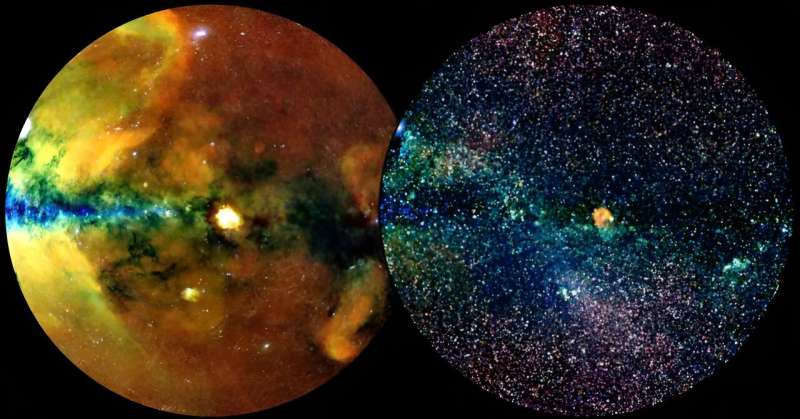The German eROSITA consortium has released the data for its share of the first all-sky survey by the soft X-ray imaging telescope flying aboard the Spectrum-RG (SRG) satellite. With about 900,000 distinct sources, the first eROSITA All-Sky Survey (eRASS1) has yielded the largest X-ray catalog ever published. The work is published in the journal Astronomy & Astrophysics.
Along with the data, the consortium released a series of scientific papers describing new results ranging from studies of the habitability of planets to the discovery of the largest cosmic structures.
Based on just the first six months of observations, eROSITA has already detected more sources than had previously been known in the 60-year history of X-ray astronomy. Now available to the worldwide science community, the data will revolutionize our knowledge of the universe at high energies.
The eRASS1 observations with the eROSITA telescope were carried out from 12 December 2019 to 11 June 2020. In the most sensitive energy range of the eROSITA detectors (0.2-2 keV), the telescope detected 170 million X-ray photons, for which the cameras can accurately measure the incoming energy and arrival time.
The catalog was then constructed—after careful processing and calibration—by detecting concentrations of photons in the sky against a bright, large-scale, diffuse background. After eRASS1, eROSITA has continued scanning the sky and accumulated several additional all-sky surveys. Those data will also be released to the world in the coming years.
The eRASS1 catalog covers half the X-ray sky, the data share of the German eROSITA consortium. It consists of more than 900,000 sources, including some 710,000 supermassive black holes in distant galaxies (active galactic nuclei), 180,000 X-ray-emitting stars in our own Milky Way, and 12,000 clusters of galaxies, plus a small number of other exotic classes of sources like X-ray-emitting binary stars, supernova remnants, pulsars, and other objects.
“These are mind-blowing numbers for X-ray astronomy,” says Andrea Merloni, eROSITA principal investigator and first author of the eROSITA catalogue paper. “We’ve detected more sources in six months than the big flagship missions XMM-Newton and Chandra have done in nearly 25 years of operation.”
Coordinated with the release, the German eROSITA Consortium has submitted almost 50 new scientific publications to journals, adding to the more than 200 that have already been published by the team before the data release.
Most of the new papers appear with selected discoveries including a giant filament of pristine warm-hot gas extending between two galaxies and two new “Quasi-Periodically Erupting” black holes. Further studies of how X-ray irradiation from a star may affect the atmosphere and water retention of orbiting planets, and statistical analysis of flickering supermassive black holes.
“The scientific breadth and impact of the survey is quite overwhelming; it’s hard to put into a few words,” says Mara Salvato, who as spokesperson for the German eROSITA consortium co-ordinates the efforts of about 250 scientists organized into 12 working groups. “But the papers published by the team will speak for themselves.”

This first eRASS data release (DR1) makes public not only the source catalog, but images of the X-ray sky at multiple X-ray energies and even lists of the individual photons with their sky positions, energies and precise arrival times.
The software needed to analyze the eROSITA data is also included in the release. For many source classes, supplementary data from other wavebands has also been incorporated into so-called “value-added” catalogs that go beyond pure X-ray information.
“We’ve made a huge effort to release high-quality data and software,” added Miriam Ramos-Ceja, who leads the eROSITA Operations team. “We hope this will broaden the base of scientists worldwide working with high-energy data and help push the frontiers of X-ray astronomy.”
“The eROSITA collaboration has done an outstanding job with the data release and at the same time publishing all of these amazing new results,” says Kirpal Nandra, Director at MPE. “There’s a lot more to come from us, and we’re looking forward to seeing what the rest of the world will do with the public data.”
Keen eROSITA-watchers may know that the driving scientific objective that motivated the telescope was to constrain cosmological models using clusters of galaxies. The cosmology results, based on an in-depth analysis of the eRASS1 clusters, will be released in approximately two weeks.
More information:
A. Merloni et al, The SRG/eROSITA all-sky survey, Astronomy & Astrophysics (2024). DOI: 10.1051/0004-6361/202347165
Citation:
First eROSITA sky-survey data release makes public the largest ever catalog of high-energy cosmic sources (2024, January 31)
retrieved 31 January 2024
from https://phys.org/news/2024-01-erosita-sky-survey-largest-high.html
This document is subject to copyright. Apart from any fair dealing for the purpose of private study or research, no
part may be reproduced without the written permission. The content is provided for information purposes only.

